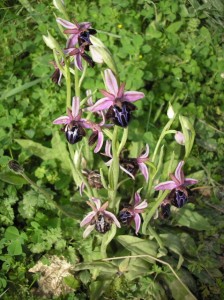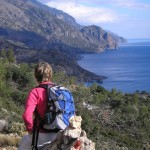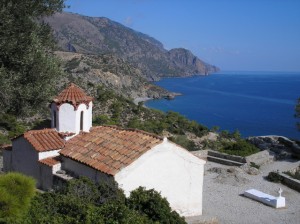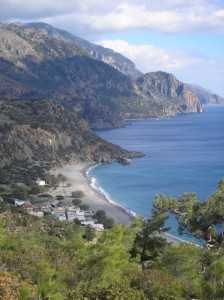Summer time begins officially on the 28th March, and the Vernal (Spring) Equinox falls the previous week. But there has been evidence of spring and summer long ago here in Crete, where the winter has been pleasantly mild. Pastel-shaded anemones appeared last November, dwarf iris in January, the spectacular bee-orchids in February, and the first hoopoe was spotted on 16th February, far earlier than usual.

Now in early March we have almond and wild pear blossom in profusion, and bright yellow gorse is beginning to cover the hillsides. Climate change is to our advantage.
Here’s a short circular walk from Sougia guaranteed to put a spring in your step. It’s around 6km, or two hours, but pause to enjoy the scenery, photograph flowers and enjoy a (recommended) picnic lunch, and it will take you twice as long. Although not difficult, it’s not an easy walk either, being rocky underfoot, so tread carefully. From Sougia walk west to the harbour, and then turn right into the mini-gorge (Kakos Potamos), where runs the E4 path to Lissos and on to Paleohora (see below). Look out for the extraordinary Dragon Lily (Dracungulus vulgaris) plants which grow here, and you may detect the nauseating smell before seeing them!

Bee Orchids
After some 15 mins, when the gorge narrows, pass below huge overhanging rock faces. Soon afterwards the path to Lissos forks left, climbing steeply out of the gorge.

Overhanging walls of the gorge
Our walk continues ahead, on a faint path occasionally marked with cairns. After approx. another 15 minutes, look for a large, distinctive pine tree, with a large red painted circle on the lower trunk. Leave the gorge at this point, climbing right, and following a way-marked route of red paint dots. Who marked this route remains a mystery, but ‘Epharisto’ whoever it was. After a steep ascent of 10/15 minutes the path drops into and skirts around a hollow.

Lynne enjoying the view
Keep following the waymarking, as the path winds between rocks and trees, at a height of c.250m above sea level. There are superb views along the south coast, and on a clear day the islands of Gavdos and Gavdopoula are visible some 50km distant to the SE.
Eventually the path rises to meet an old bull-dozed track. Follow this right, descending and curving first right and then left, alongside a wire fence.

Agia Irini Church
A rough track leads downhill, then take a sharp right turn through fencing, and a short detour to the delightfully situated small church of Agia Irini, dating from the 12th century. A place to rest awhile and relax. Below the church the track winds down to the outskirts of Sougia, where you must decide whether to turn left into the village and cafes, or right to the sea and a swim. A tough decision ………

Looking down to Sougia
There is more to Sougia then meets the eye. Visit www.sougia.com for further information.
The route from Sougia to Paleohora (and nine more!) is described in our book ‘Ten Walks around Paleohora’, available from ‘To Delfini’ bookshop in the village centre.


Recent Comments